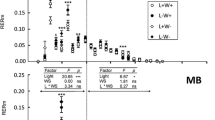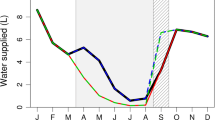Abstract
Key message
Primary growth is less sensitive than secondary growth to water and phloem blockage in maritime pine saplings, with variations in radial growth resulting from tracheid production without altering their size.
Abstract
In plants, primary and secondary growth is regulated by internal and external factors. However, apical and cambial meristems may not respond in the same way. In this study, we disentangle the role of carbon and water availability on stem growth (primary and secondary) and on anatomical tracheid features by investigating the effect of stem girdling (phloem blockage vs. no phloem blockage) and water availability (control vs. drought) in three-year-old Pinus pinaster saplings. We found that primary growth was similar among treatments, while secondary growth was affected by both treatments. Tree ring-width increment in saplings subjected to drought corresponded to half of that on control plants, and phloem blockage enhanced ring width under guidelines soil water conditions. These differences in the radial growth resulted mainly from an increase in tracheid production, which also increased with phloem blockage (above the girdling), regardless the water regime. However, the seasonal pattern of tracheid features was mainly explained by individuals and to a less extent by the water regime and girdling. Contrasting seasonal patterns between treatments were found only on cell wall thickness, showing a faster decrease with increasing water constrains in the drought group than in the control one. The absence of treatment effects on primary growth in P. pinaster saplings suggests a trade-off between the priority in plant development and meristem sensitivity to environmental conditions.





Similar content being viewed by others
Available data and material
Not applicable.
References
Adams HD, Collins AD, Briggs SP et al (2015) Experimental drought and heat can delay phenological development and reduce foliar and shoot growth in semiarid trees. Glob Chang Biol 21:4210–4220. https://doi.org/10.1111/gcb.13030
Andivia E, Madrigal-González J, Villar-Salvador P, Zavala MA (2018) Do adult trees increase conspecific juvenile resilience to recurrent droughts? Implications for forest regeneration. Ecosphere 9:1–13. https://doi.org/10.1002/ecs2.2282
Bhalerao RP, Fischer U, Turner S (2016) Environmental and hormonal control of cambial stem cell dynamics. J Exp Bot 68:79–87. https://doi.org/10.1093/jxb/erw466
Bloemen J, Vergeynst LL, Overlaet-Michiels L, Steppe K (2016) How important is woody tissue photosynthesis in poplar during drought stress? Trees - Struct Funct 30:63–72. https://doi.org/10.1007/s00468-014-1132-9
Cabon A, Fernández-de-Uña L, Gea-Izquierdo G et al (2019) Water potential control of turgor-driven tracheid enlargement in Scots pine at its xeric distribution edge. New Phytol 44:3. https://doi.org/10.1111/nph.16146
Camarero JJ, Olano JM, Parras A (2010) Plastic bimodal xylogenesis in conifers from continental Mediterranean climates. New Phytol 185:471–480. https://doi.org/10.1111/j.1469-8137.2009.03073.x
Campelo F, Vieira J, Nabais C (2013) Tree-ring growth and intra-annual density fluctuations of Pinus pinaster responses to climate: Does size matter? Trees - Struct Funct 27:763–772. https://doi.org/10.1007/s00468-012-0831-3
Campelo F, Gutiérrez E, Ribas M et al (2018) The facultative bimodal growth pattern in Quercus ilex – A simple model to predict sub-seasonal and inter-annual growth. Dendrochronologia 49:77–88. https://doi.org/10.1016/j.dendro.2018.03.001
Carbone MS, Czimczik CI, Keenan TF et al (2013) Age, allocation and availability of nonstructural carbon in mature red maple trees. New Phytol 200:1145–1155. https://doi.org/10.1111/nph.12448
Cartenì F, Deslauriers A, Rossi S et al (2018) The physiological mechanisms behind the earlywood-to-latewood transition: a process-based modeling approach. Front Plant Sci 9:1–12. https://doi.org/10.3389/fpls.2018.01053
Carvalho A, Nabais C, Vieira J et al (2015) Plastic response of tracheids in Pinus pinaster in a water-limited environment: Adjusting lumen size instead of wall thickness. PLoS ONE 10:1–14. https://doi.org/10.1371/journal.pone.0136305
Cuny HE, Rathgeber CBK, Frank D et al (2015) Woody biomass production lags stem-girth increase by over one month in coniferous forests. Nat Plants 1:15160. https://doi.org/10.1038/nplants.2015.160
Daudet FA, Améglio T, Cochard H et al (2005) Experimental analysis of the role of water and carbon in tree stem diameter variations. J Exp Bot 56:135–144. https://doi.org/10.1093/jxb/eri026
De Schepper V, Steppe K (2011) Tree girdling responses simulated by a water and carbon transport model. Ann Bot 108:1147–1154. https://doi.org/10.1093/aob/mcr068
De Schepper V, Steppe K (2013) Tree girdling: a tool to improve our understanding of couppled sugar and water transport. Acta Hortic 990:313–320. https://doi.org/10.17660/ActaHortic.2013.990.37
De Micco V, Saurer M, Aronne G et al (2007) Variations of wood anatomy and δ13C within-tree rings of coastal Pinus pinaster showing intra-annual density fluctuations. IAWA J 28:61–74. https://doi.org/10.1163/22941932-90001619
De Schepper V, Steppe K, Van Labeke MC, Lemeur R (2010) Detailed analysis of double girdling effects on stem diameter variations and sap flow in young oak trees. Environ Exp Bot 68:149–156. https://doi.org/10.1016/j.envexpbot.2009.11.012
Derbyshire P, Findlay K, McCann MC, Roberts K (2007) Cell elongation in Arabidopsis hypocotyls involves dynamic changes in cell wall thickness. J Exp Bot 58:2079–2089. https://doi.org/10.1093/jxb/erm074
Deslauriers A, Giovannelli A, Rossi S et al (2009) Intra-annual cambial activity and carbon availability in stem of poplar. Tree Physiol 29:1223–1235. https://doi.org/10.1093/treephys/tpp061
Dietze MC, Sala A, Carbone MS et al (2014) Nonstructural Carbon in Woody Plants. Annu Rev Plant Biol 65:2.1-2.21. https://doi.org/10.1146/annurev-arplant-050213-040054
Domec J-C, Johnson DM (2012) Does homeostasis or disturbance of homeostasis in minimum leaf water potential explain the isohydric versus anisohydric behavior of Vitis vinifera L. cultivars? Tree Physiol 32:245–248. https://doi.org/10.1093/treephys/tps013
Domec JC, Pruyn ML (2008) Bole girdling affects metabolic properties and root, trunk and branch hydraulics of young ponderosa pine trees. Tree Physiol 28:1493–1504. https://doi.org/10.1093/treephys/28.10.1493
Fajstavr M, Giagli K, Vavrčík H, et al (2017) The effect of stem girdling on xylem and phloem formation in Scots pine. Silva Fenn 51:1–22. https://doi.org/10.14214/sf.1760
Garcia-Forner N, Vieira J, Nabais C et al (2019) Climatic and physiological regulation of the bimodal xylem formation pattern in Pinus pinaster saplings. Tree Physiol 39:2008–2018. https://doi.org/10.1093/treephys/tpz099
Gebauer R, Plichta R, Bednářová E et al (2018) How timing of stem girdling affects needle xylem structure in Scots pine. Eur J for Res 137:57–67. https://doi.org/10.1007/s10342-017-1090-z
Hsiao TC (1973) Plant Responses to Water Stress. Ann Rev Plant Physiol 89:519–570. https://doi.org/10.1146/annurev.pp.24.060173.002511
Hsiao TC, Xu L (2000) Sensitivity of growth of roots versus leaves to water stress: biophysical analysis and relation to water transport. J Exp Bot 51:1595–1616. https://doi.org/10.1093/jexbot/51.350.1595
Huang R, Becker AA, Jones IA (2012) Modelling cell wall growth using a fibre-reinforced hyperelastic-viscoplastic constitutive law. J Mech Phys Solids 60:750–783. https://doi.org/10.1016/j.jmps.2011.12.003
Klein T, Yakir D, Hoch G, Körner C (2014) Drought stress, growth, and nonstructural carbohydrate dynamics of pine trees in a semi-arid forest. Tree Physiol 16:5042. https://doi.org/10.1093/treephys/tpu071
Lastdrager J, Hanson J, Smeekens S (2014) Sugar signals and the control of plant growth and development. J Exp Bot 65:799–807. https://doi.org/10.1093/jxb/ert474
Lempereur M, Martin-StPaul NK, Damesin C et al (2015) Growth duration is a better predictor of stem increment than carbon supply in a Mediterranean oak forest : implications for assessing forest productivity under climate change. New Phytol 207:579–590. https://doi.org/10.1111/nph.13400
López R, Brossa R, Gil L, Pita P (2015) Stem girdling evidences a trade-off between cambial activity and sprouting and dramatically reduces plant transpiration due to feedback inhibition of photosynthesis and hormone signaling. Front Plant Sci 6:1–13. https://doi.org/10.3389/fpls.2015.00285
Maier CA, Johnsen KH, Clinton BD, Ludovici KH (2010) Relationships between stem CO2 efflux, substrate supply, and growth in young loblolly pine trees. New Phytol 185:502–513. https://doi.org/10.1111/j.1469-8137.2009.03063.x
Martínez-Vilalta J, Garcia-Forner N (2017) Water potential regulation, stomatal behaviour and hydraulic transport under drought: deconstructing the iso/anisohydric concept. Plant Cell Environ 40:962–976. https://doi.org/10.1111/pce.12846
Maunoury-Danger F, Fresneau C, Eglin T et al (2010) Impact of carbohydrate supply on stem growth, wood and respired CO2 δ13C: Assessment by experimental girdling. Tree Physiol 30:818–830. https://doi.org/10.1093/treephys/tpq039
Minchin PEH, Lacointe A (2005) New understanding on phloem physiology and possible consequences for modelling long-distance carbon transport. New Phytol 166:771–779. https://doi.org/10.1111/j.1469-8137.2005.01323.x
Mitchell PJM, O’Grady AP, Tissue DT et al (2014) Co-ordination of growth, gas exchange and hydraulics define the carbon safety margin in tree species with contrasting drought strategies. Tree Physiol 34:443–458. https://doi.org/10.1093/treephys/tpu014
Oberhuber W, Gruber A, Lethaus G et al (2017) Stem girdling indicates prioritized carbon allocation to the root system at the expense of radial stem growth in Norway spruce under drought conditions. Environ Exp Bot 138:109–118. https://doi.org/10.1016/j.envexpbot.2017.03.004
Piper FI, Fajardo A, Hoch G (2017) Single-provenance mature conifers show higher non-structural carbohydrate storage and reduce growth in a drier location. Tree Physiol. https://doi.org/10.1093/treephys/tpx071
R Core Team (2020) R: A Language and Environment for Statistical Computing. R Foundation for Statistical Computing, Viena. Austria. URL https://www.R-project.org/
Refrégier G, Peletier S, Jaillard D, Hōfte H (2004) Interaction between wall deposition and cell elongation in dark-grown hypocotyl cells in arabidopsis. Plant Physiol 135:959–968. https://doi.org/10.1104/pp.104.038711.agents
Rigling A, Waldner PO, Forster T et al (2001) Ecological interpretation of tree-ring width and intraannual density fluctuations in Pinus sylvestris on dry sites in the central Alps and Siberia. Can J for Res 31:18–31. https://doi.org/10.1139/cjfr-31-1-18
Rossi S, Simard S, Rathgeber CBK et al (2009) Effects of a 20-day-long dry period on cambial and apical meristem growth in Abies balsamea seedlings. Trees - Struct Funct 23:85–93. https://doi.org/10.1007/s00468-008-0257-0
Sala A, Woodruff DR, Meinzer FC (2012) Carbon dynamics in trees: feast or famine? Tree Physiol 32:764–775. https://doi.org/10.1093/treephys/tpr143
Schindelin J, Arganda-Carrera I, Frise E et al (2009) Fiji - an Open platform for biological image analysis. Nat Methods 9:1–15. https://doi.org/10.1038/nmeth.2019.Fiji
Seo JW, Eckstein D, Schmitt U (2007) The pinning method: From pinning to data preparation. Dendrochronologia 25:79–86. https://doi.org/10.1016/j.dendro.2007.04.001
Steppe K, Sterck F, Deslauriers A (2015) Diel growth dynamics in tree stems: Linking anatomy and ecophysiology. Trends Plant Sci 20:335–343. https://doi.org/10.1016/j.tplants.2015.03.015
Teixeira RT, Sheng X, Brunner AM (2019) Activity of the shoot apical and cambial meristems: Coordination and responses to environmental signals, Advances in Botanical Research, Chapter 6, 1st ed.. Elsevier Ltd. ISSN 0065–2296. https://doi.org/10.1016/bs.abr.2018.11.006
Tomasella M, Petrussa E, Petruzzellis F et al (2020) The possible role of non-structural carbohydrates in the regulation of tree hydraulics. Int J Mol Sci. https://doi.org/10.3390/ijms21010144
Vandegehuchte MW, Bloemen J, Vergeynst LL, Steppe K (2015) Woody tissue photosynthesis in trees: Salve on the wounds of drought? New Phytol 208:998–1002. https://doi.org/10.1111/nph.13599
Verbančič J, Lunn JE, Stitt M, Persson S (2018) Carbon supply and the regulation of cell wall synthesis. Mol Plant 11:75–94. https://doi.org/10.1016/j.molp.2017.10.004
Vieira J, Nabais C, Rossi S et al (2017) Rain exclusion affects cambial activity in adult maritime pines. Agric for Meteorol 237:303–310. https://doi.org/10.1016/j.agrformet.2017.02.024
Vieira J, Moura M, Nabais C et al (2019) Seasonal adjustment of primary and secondary growth in maritime pine under simulated climatic changes. Ann for Sci. https://doi.org/10.1007/s13595-019-0865-4
Vieira J, Carvalho A, Campelo F (2020) Tree growth under climate change: evidence from xylogenesis timings and kinetics. Front Plant Sci 11:1–11. https://doi.org/10.3389/fpls.2020.00090
Winkler A, Oberhuber W (2017) Cambial response of Norway spruce to modified carbon availability by phloem girdling. Tree Physiol 37:1527–1535. https://doi.org/10.1093/treephys/tpx077
Zweifel R, Zimmermann L, Zeugin F, Newbery DM (2006) Intra-annual radial growth and water relations of trees: Implications towards a growth mechanism. J Exp Bot 57:1445–1459. https://doi.org/10.1093/jxb/erj125
Acknowledgements
We thank InProPlant for the use of their facilities and their help with the experiment and David Bonito for his valuable help in the laboratory.
Funding
This study was supported by the FCT – Portuguese Foundation for Science and Technology co-financed by COMPETE 2020 through the project PTDC/AAG-GLO/4784/2014. The investigation was carried out at the R&D Unit Center for Functional Ecology – Science for People and the Planet, with reference UIDB/04005/2020, financed by FCT I.P./MCTES through national funds (PIDDAC).
Author information
Authors and Affiliations
Corresponding author
Ethics declarations
Conflict of interest
Not applicable.
Ethics approval
Not applicable.
Consent to participate
Not applicable.
Consent for publication
Not applicable.
Additional information
Communicated by Gaertner.
Publisher's Note
Springer Nature remains neutral with regard to jurisdictional claims in published maps and institutional affiliations.
Supplementary Information
Below is the link to the electronic supplementary material.
Rights and permissions
About this article
Cite this article
Garcia-Forner, N., Carvalho, A. & Campelo, F. Water and stem girdling affect the tracheids’ number more than their shape in Pinus pinaster saplings. Trees 35, 1921–1931 (2021). https://doi.org/10.1007/s00468-021-02160-5
Received:
Accepted:
Published:
Issue Date:
DOI: https://doi.org/10.1007/s00468-021-02160-5




